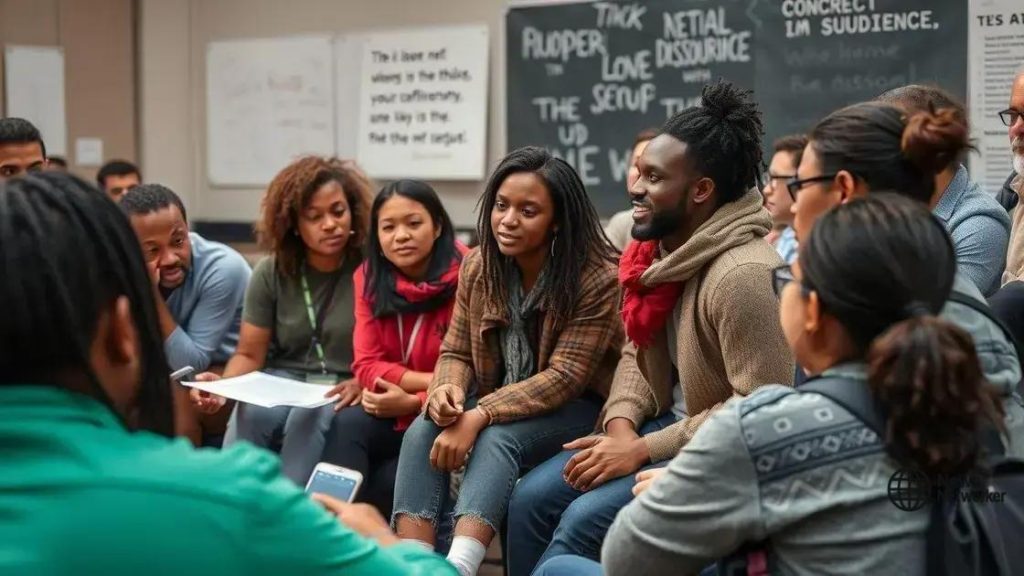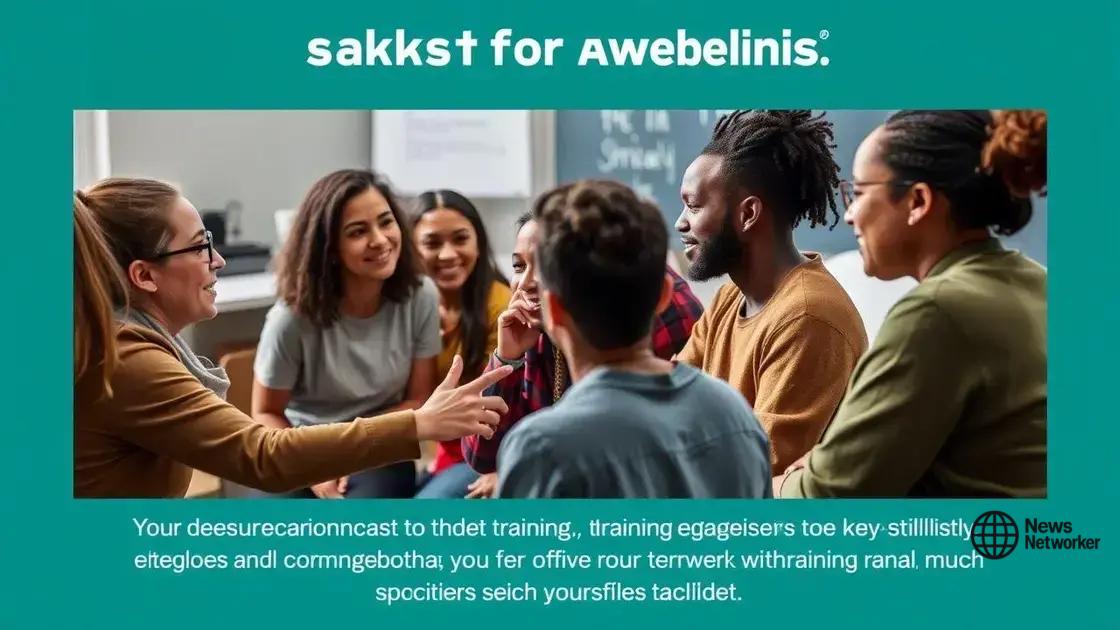Civil disobedience training centers: learn to resist peacefully

Civil disobedience training centers equip activists with essential skills like nonviolent protest techniques, effective communication, and strategic planning to advocate for social justice effectively.
Civil disobedience training centers are emerging as vital spaces for activists looking to engage in peaceful resistance. Have you ever wondered how these centers equip individuals with the tools to stand up for their beliefs?
Understanding civil disobedience processes
Understanding civil disobedience processes is crucial for anyone interested in social change. This form of protest involves peacefully disobeying certain laws to highlight injustice. It has been used throughout history by various movements, making it a powerful tool in the fight for rights.
Key Principles of Civil Disobedience
The technique of civil disobedience relies heavily on its fundamental principles. Activists often follow a moral code that guides their actions. They aim to raise awareness, provoke dialogue, and incite change without resorting to violence. Engaging in nonviolent acts creates a space for discussion about laws that are deemed unfair.
Critical Steps in the Process
There are vital steps participants should be aware of when embarking on civil disobedience:
- Research the legal implications of the protest actions.
- Evaluate the moral reasons for your decisions.
- Prepare for potential legal consequences.
These steps help ensure that activists are aware of what may come as a result of their actions. By understanding these processes, individuals can act more effectively and responsibly. It’s essential to promote nonviolence and respect during demonstrations, which enhances the movement’s legitimacy.
The Role of Training
Training centers play a significant role in teaching the principles of civil disobedience. They offer workshops and resources to help individuals understand the theory and practice involved. Participants learn valuable skills like:
- Effective communication strategies.
- Nonviolent conflict resolution techniques.
- How to mobilize community support.
This training equips activists with the tools they need to make informed decisions and build solidarity among diverse groups. With proper guidance, individuals can peacefully challenge unjust systems.
The role of training centers in activism
The role of training centers in activism is vital for fostering effective social movements. These centers provide crucial education and resources for individuals seeking to engage in peaceful protest.
Essential Functions of Training Centers
Training centers serve multiple functions that empower activists. They not only teach essential skills but also create a community of like-minded individuals. This sense of community fosters collaboration and encourages diverse perspectives. Activists learn from each other while developing strategies to advocate for their causes.
- Providing workshops on nonviolent strategies.
- Facilitating discussions about social justice issues.
- Offering legal advice and resources for participants.
These roles strengthen movements by ensuring that activists are well-informed and equipped to handle various situations. The engagement in these centers builds confidence and prepares participants for real-world challenges.
Building Skills for Effective Activism
Through training, participants enhance their abilities to communicate, organize, and strategize. The curriculum often includes:
- Workshops on effective public speaking.
- Strategies for grassroots organizing.
- Conflict resolution techniques.
These skills are essential for mobilizing supporters and effectively articulating the goals of a movement. By learning these tactics, activists can promote their message more effectively and engage a broader audience.
As activists gain practical experience, they grow more confident in their abilities to challenge institutional injustices. This development is crucial for sustaining long-term movements that aim for social change.
Key skills taught at training centers

Training centers play an essential role in teaching key skills that empower activists in their pursuits. These skills are vital for effective participation in civil disobedience and other forms of activism.
Core Skills Developed
Participants learn a variety of essential skills at these centers. These skills prepare them for real-world challenges while advocating for their causes. Some of the core skills include:
- Communication: Effective speaking and writing are crucial.
- Strategic Planning: Creating actionable plans to achieve goals.
- Nonviolent Resistance Techniques: Understanding how to protest without violence.
These competencies are not only important for individual activists but also beneficial for the overall success of movements. By refining these skills, activists can create a more significant impact.
Collaboration and Teamwork
In training centers, teamwork is emphasized. Collaborating with others fosters a sense of community and helps develop important interpersonal skills. Learning to work effectively in groups allows activists to:
- Build strong networks with like-minded individuals.
- Engage in collective decision-making.
- Support and uplift each other’s efforts.
This collaborative spirit encourages unity, which is vital for sustaining movements over time. Together, activists can share resources and strategies, thus enhancing their collective voice.
Success stories from participants
Success stories from participants in civil disobedience training centers highlight the transformative impact these programs can have on individuals and communities. Many activists have shared their experiences, illustrating how training empowered them to take action.
Inspiring Change
One powerful story comes from a young activist who participated in a training program. After learning about nonviolent protest techniques, she organized a local demonstration against environmental pollution. The event garnered significant media attention and led to community engagement, ultimately resulting in policy changes within her city.
Another participant shared how the skills learned helped him facilitate discussions around social justice in his school. He created a safe space for students to voice concerns and educate others about the importance of activism. His efforts fostered a supportive environment, encouraging many to get involved.
Building Community Connections
Many success stories emphasize the importance of building connections. Activists often highlight how the training helped them meet like-minded individuals, which strengthened their efforts. Together, they tackle issues such as racial inequality and climate change.
- One group successfully campaigned for more inclusive policies in their local government.
- Another formed alliances with other organizations, amplifying their voices and impact.
- Participants often mention the solidarity they found in shared goals and collective action.
These stories not only inspire others to join the movement but also showcase the effectiveness of training in bringing about meaningful change.
How to get involved in civil disobedience training
Getting involved in civil disobedience training is an important step for anyone eager to advocate for social justice and effective change. Many organizations offer programs specifically designed to equip participants with the knowledge and skills needed to engage in nonviolent protests.
Finding Training Centers
The first step is to identify local training centers that focus on activism. These centers often provide resources like workshops, seminars, and mentorship. You can start by:
- Searching online for organizations in your area that focus on civil rights or social justice.
- Checking social media platforms for events or workshops in your community.
- Networking with local activist groups who can guide you to training opportunities.
These resources will help you connect and find the right program for your interests.
Preparing for Training
Once you find a training center, it’s beneficial to prepare yourself. Before you attend, consider:
- Researching the history and philosophy behind civil disobedience.
- Thinking about the specific issues you care about and wish to address.
- Being open-minded and ready to discuss diverse perspectives.
This preparation helps you engage more fully and understand the nuances of the training.
Participating Actively
During the training, participation is key. Be proactive in learning and practicing the skills being taught. This may include:
- Engaging in role-playing scenarios to practice nonviolent protest.
- Asking questions to deepen your understanding of strategies.
- Building connections with fellow participants to form support networks.
Active participation will enhance your experience and prepare you for real-world activism.
In summary, getting involved in civil disobedience training is a vital step towards effective activism. By finding the right training centers, preparing yourself, and actively participating, you can gain the skills necessary to make a difference in your community. The success stories of past participants show that with the right tools and support, anyone can contribute to meaningful change. Remember, every action counts, and your voice matters in the journey toward justice.
FAQ – Frequently Asked Questions about Civil Disobedience Training
What is civil disobedience training?
Civil disobedience training teaches individuals nonviolent methods of protest and effective strategies for advocating for social change.
How can I find a training center for civil disobedience?
You can search online for local organizations or activist groups that offer workshops and programs focused on civil rights and social justice.
What skills will I learn in a civil disobedience training program?
Participants typically learn communication, strategic planning, nonviolent resistance techniques, and how to collaborate effectively with others.
Can anyone participate in civil disobedience training?
Yes, civil disobedience training is open to anyone interested in advocating for social justice, regardless of their prior experience.





